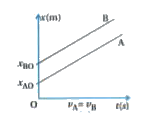are vector along x-axis and y-axis respectively. Find the resultant vectorSolution in Gujrati
Consider two particles A and B moving along the X-axis with uniform velocity
Let be their displacemetn from the origin O at
If arfe tieir position co-ordinates then at
At the displacement of particle B with respect to particle A,
where =displacement of particle B with respect to particle A at t =0 and is the relative velocity of B with respect to particle A.

When then from equation this means that the distance between two particles will remain equal to initial distance at any instant of time.

If both teh particles will meet at time t at this instant their relative displacment will beThese after particle A overtakes particle B at this time.
If then the relative displacment of both the particles will increase with time. Therefore they will never meetn on their path.

If the velocities of two trains moving in mutually opposite directions are respectively, then
Let, train A is moving in positive direction and train B is moving in negative direction, then
and
Hence, the relative velocity is greater than individual velocities of the trains.
Topper's Solved these Questions
- MOTION IN A STRAIGHT LINE BOOK - KUMAR PRAKASHANCHAPTER - MOTION IN A STRAIGHT LINE EXERCISE - SECTION-A TRY YOUR SELF (VSQs)
52 Videos
- MOTION IN A STRAIGHT LINE BOOK - KUMAR PRAKASHANCHAPTER - MOTION IN A STRAIGHT LINE EXERCISE - SECTION-B
58 Videos
- MECHANICAL PROPERTIES OF FLUIDS BOOK - KUMAR PRAKASHANCHAPTER - MECHANICAL PROPERTIES OF FLUIDS EXERCISE - QUESTION PAPER (SECTION -C)
3 Videos
- OBJECTIVE QUESTIONS AS PER NEW PAPER STYLE BOOK - KUMAR PRAKASHANCHAPTER - OBJECTIVE QUESTIONS AS PER NEW PAPER STYLE EXERCISE - CHAPTER - 8 (Match Type questions)
5 Videos
Similar Questions
How can we determine whether the object is in rest or not?
View SolutionA car is moving along a straight line, say OP in It move from O to P in 18 s and returns from P to Q in 6s, where OP=360 m and OQ=240 m. What are the average velocity and average speed of the car in going (a) from O to P ? And (b) from O to P and back to Q ?
View SolutionGlycerine flows steadily through a horizontal tube of length 1.5m and radius 1.0 cm . If the amount of glycerine collected per second at one is 4.0×10−3kgs−1 , what is the pressure difference between the two ends of the tube ? (Density of glycerine =1.3×10103kgm−3 and viscosity of glycerine =0.83 Pa s). [ you may also like to check if the assumption of laminar flow in the tube is correct]
View SolutionType of satellites are given in Column-I and their uses are given in Column-II. Match them properly :
Column-IColumn-II(1) Polar satellite(a) Tele communication(2) Geo-stationary satellite(b) Investigation(c) For information about atmosphere
View SolutionA vector has component along the X-axis equal to 25 unit and along the Y-axis equl to 60 unit. Find the magnitude and direction of the vector.
View SolutionThe vector that must be added to the vector ˆi−3ˆj+2ˆk and 3ˆi+6ˆj+7ˆk so that the resultant vector is a unit vector along the y-axis is
View SolutionIf force vector is along X-axis and radius vector is along Y-axis then the direction of torque is
View SolutionDuring rotation of a body, the position vector is along X-axis and force vector is along Y-axis, The direction of torque vector is
View SolutionA vector →X, when added to the resultant of the vectors →A=3ˆi−5ˆj+7ˆk and →B=2ˆi+4ˆj−3ˆk gives a unit vector along Y-axis. Find the vector →X.
View Solution→A=3ˆi+4ˆj तथा →B=12ˆi−5ˆj जहाँ ˆi तथा ˆj क्रमशः +X− तथा +Y− अक्ष की दिशा में एकांक सदिश हैं | ज्ञात कीजिए : (i) →A का परिणाम तथा (ii) →A⋅→B का मान |
View Solutionएक सदिश x - अक्ष और y - अक्ष में से प्रत्येक के साथ 60∘ का कोण बनाता है । इसके द्वारा z - अक्ष से बना कोण ज्ञात कीजिए ।
View SolutionIf →A=ˆi+4ˆj+ˆkand→B=3ˆi−5ˆj+ˆk, find the unit vector along any vector parallel to the resultant of →Aand→B.
View SolutionWhen a vector →C is added to the resultant of vectors
→A=ˆi+4ˆj−2ˆkand→B=3ˆi−5ˆj+ˆk, a unit vector along
Z-axis is obtained . Find the vector →C
View SolutionWhich vector should be added to 2hati + 4hatj -3hatk and 3hati-5hatj+7hatk to get a unit vector along y-axis ?
View Solutionसदिश 3ˆi+4ˆk का y- अक्ष पर प्रक्षेप होगा
View Solution
